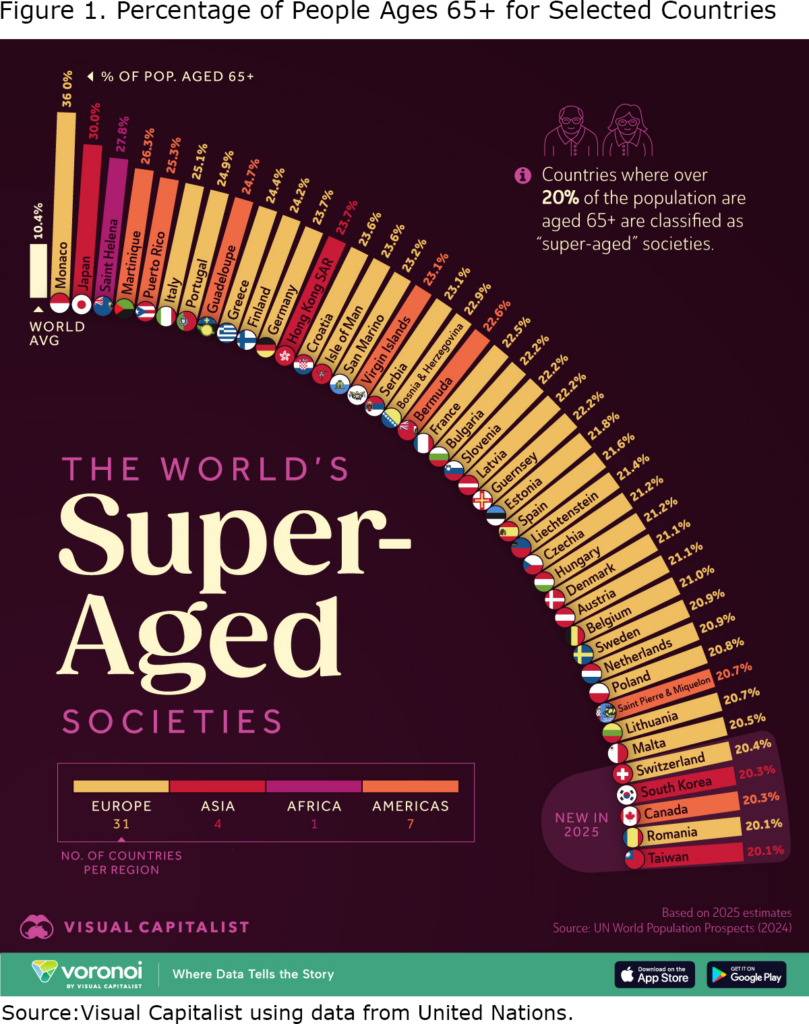The Shrinking Of Japan: A Harbinger Of What Will Happen To The U.s.?

The graphic below (Figure 1) of the oldest societies in the world – from Visual Capitalist – is both striking and somewhat misleading. Monaco is far older than any other country, no doubt because you have to be old and rich to afford to live there. Many of the other places on the list are tropical island retirement paradises, including the U.S. Virgin Islands.
Comparing Japan and the United States
It’s worth taking a look at Japan’s demographics since they could paint a picture of what we and other developed nations will face in coming years. Their population today has an estimated median age of 49.8 years compared to 38.5 years in the United States. Japan has a fertility rate of just 1.2 births per woman and a low percentage of women currently in their childbearing years. The U.S. fertility rate is 1.6 births per woman, still well below the replacement rate of 2.1. Not surprisingly, Japan’s total population has already been slowly declining, and the pace of decline is likely to accelerate in coming years.
One reason that Japan is so much older than the United States is that the Japanese live longer. Their average life expectancy at birth is 84.9 years as compared with 79.5 years in the United States. (Most of these statistics are from Worldometer.)
Many fear a demographic collapse in Japan if current trends continue. According to one commentator: “The Japanese government projects that, if this trend is not reversed, the country’s current 125 million inhabitants will drop to 100 million around 2050…The demographic downward curve is so steep that it threatens the strength of the country’s economic future.”
What About the United States?
While the United States has seen a steep drop in fertility over time, the good news part of this trend is that there are many fewer teen births than in prior years (see Figure 2). Teen births have dropped by a whopping 73 percent from the 1990 level. During the same period, the number of births to women over 40 have tripled, though that still does not amount to the bulk of new babies, just about 4 percent of all births.
According to Jennifer D. Sciubba, President of the Population Reference Bureau, we may see the number of births increase somewhat in coming years because “the youngest Millennial women are now 29 years old, so prime reproductive years. As a group, Millennials are much larger than the Gen X women now exiting their reproductive years, so that means more potential mothers.”
Keep the Immigrants Coming
Still, the U.S. population will continue aging; and this trend will be exacerbated if we limit immigration. So, what happens if we cut off the immigration spigot? The Census Bureau runs population projections based on various immigration assumptions. Their middle projection foresees the U.S. population peaking at about 370 million in 2080, before declining slightly by 2100. It projects that with high levels of immigration the total population could reach 435 million by 2100, but that a low-immigration scenario would lead to our population declining to 319 million by 2100.
Elon Musk has suggested that the solution is for everyone to have more children, or at least for those who live in developed nations to follow his example. But that appears to buck the trend of women having fewer children as they gain education and financial stability.
Given that the populations of most African countries and India continue to grow at great rates, and many parts of the world are suffering from the effects of climate change, wouldn’t it be a lot easier to simply keep the flow of immigrants coming? They certainly contribute a lot to the country. Musk himself is one example.
For more from Harry Margolis, check out his Risking Old Age in America blog and podcast. He also answers consumer estate planning questions at AskHarry.info. To stay current on the Squared Away blog, join our free email list. You’ll receive just one email each week.
Popular Products
-
 Glow-in-the-Dark Outdoor Pickleball B...
Glow-in-the-Dark Outdoor Pickleball B...$50.99$34.78 -
 Fiberglass Pickleball Paddle Set
Fiberglass Pickleball Paddle Set$35.99$24.78 -
 Door Pickleball Trainer Rebounder
Door Pickleball Trainer Rebounder$51.99$35.78 -
 Tennis Racket Lead Tape - 20Pcs
Tennis Racket Lead Tape - 20Pcs$31.99$21.78 -
 Large Wall Calendar Planner
Large Wall Calendar Planner$47.99$32.78